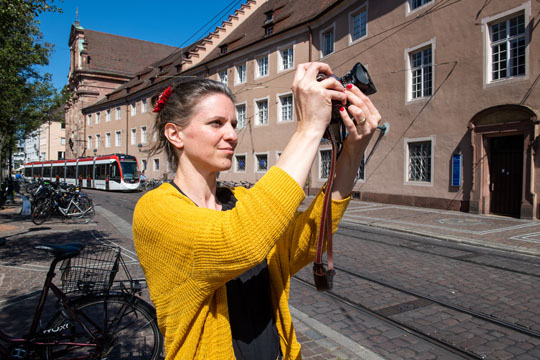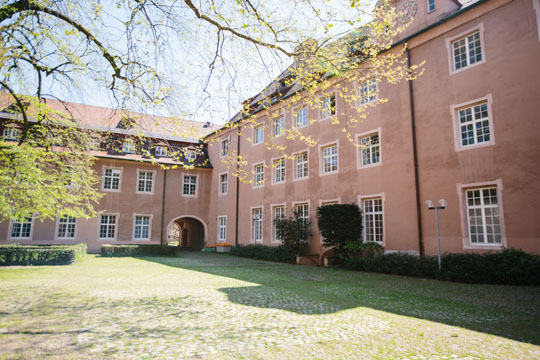One Building, Many Perspectives
Freiburg, Aug 14, 2020
Two trees stand in the courtyard of the Alte Universität (Old University) in Bertoldstraße 17: a lime tree and a plane. They were planted during the revolution of 1848/49. What do the trees symbolize? And why does hardly anyone come into the courtyard to admire them? What is the future for the building, the courtyard and the trees? At the University College Freiburg (UCF) of the Albert Ludwig University students went into these and other questions on a course. The result is a virtual journey.
 Capturing the atmosphere of the Alte Uni: historian Marie Muschalek collected photographic material for her course, which she had to switch to online at short notice. Photo: Klaus Polkowski
Capturing the atmosphere of the Alte Uni: historian Marie Muschalek collected photographic material for her course, which she had to switch to online at short notice. Photo: Klaus Polkowski
Her fascination with the Alte Universität led historian Dr. Marie Muschalek to offer a course ‘Die Alte Universität: Bildungs(t)räume im Wandel der Zeit’ or ‘The Old University: educational dreams/spaces through the ages’ on her Liberal Arts and Sciences degree program. What makes the building so fascinating to her is both its special atmosphere and the many uses it has been put to. In the 15th century there were two 'Bursen' here – residential communities for students of the university, which was founded in 1457. In 1620 the Jesuits took over the educational institution. From the 1680s to the early 18th century they built up the Alte Uni as we know it today.
These days, students of various nationalities and disciplines and staff from various departments come and go, and many others who don’t study or work at the university are guests here. The Alte Uni houses amongst other things the Uniseum, and is also home to the UCF. So holding a course about the building in that spot was a promising idea. But then came coronavirus. “At first I was a bit desperate,” admits Muschalek. “Having to give the course about the building online was a sad prospect.”
 The courtyard of the Alte Uni is one of the most idyllic places on Freiburg Campus. Photo: Sandra Meyndt
The courtyard of the Alte Uni is one of the most idyllic places on Freiburg Campus. Photo: Sandra Meyndt
Cloistered voices
But it’s an ill wind that brings nobody any good: Muschalek re-planned the class as a project course. In other words not focusing on meeting up in large groups, but on individual work in small teams. Since students were unable to visit the building easily because of the corona pandemic, a lot was switched to online. Three groups looked at the past, present and future of the building. The work of the ‘Past’ group has given rise to an audio guide. This won’t just present historic background details, student Carla Hartmann explains, “We want to stimulate listeners’ own ideas.” One of the questions that came up was why some things are seen as venerable and others aren’t. For instance the cloister, or colonnade that surrounds the courtyard: in earlier days it was a place of discourse “now there are bike racks”, says team colleague Kaspar Lehnert, with a smile. “It can make you wonder who actually decides what is worth preserving and what isn’t.”
The other groups were no less creative. The students who looked at the present day set up an Instagram account. “We wanted to use it to show individual experiences of learning at UCF,” says Kutayba Al Kanatri. The third group was dedicated to the future of the building in particular and education in general. This led to a website with podcast and photos. The team asked people visiting the building how they saw the future of the Alte Uni. In some cases the results were frustrating, reports Lotta Dümeland. “There were great ideas, especially for the courtyard. Only we’re unable to implement them.” Fire safety and listed building status make major structural changes impossible.
One of the most beautiful college buildings
Despite disappointments like this, the students treasure the experience: “The course was very practically structured,” says Kanatri. “It’s not usually like that, most courses are pretty theoretical.” Naturally there were also texts to read and discuss, but at the heart of everything was the practical work. In addition the students very much enjoyed the fact that they had a lot of freedom to plan their ideas – and that Marie Muschalek didn’t just make them look at the past.
So why does a historian place so much importance on the present and the future? “History is always linked with the present,” says Muschalek. “And for the future it’s important to know history. The building is a great reason to contemplate the future.” Furthermore the researcher is passionate about the Alte Uni herself. She found a website on the Internet with all the university colleges of Europe. Her opinion is, “Freiburg has one of the most beautiful college buildings.” The place also represents cross-border ideals, as the trees which were planted during the revolution of 1848/49 stand for Germany and Europe. More details can be found on the ‘AU-f einer Reise’ website which was created as a result of the course.
Pascal Lienhard

